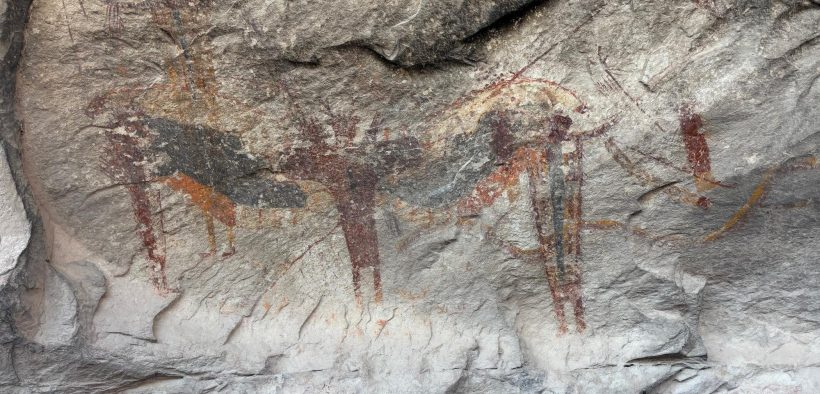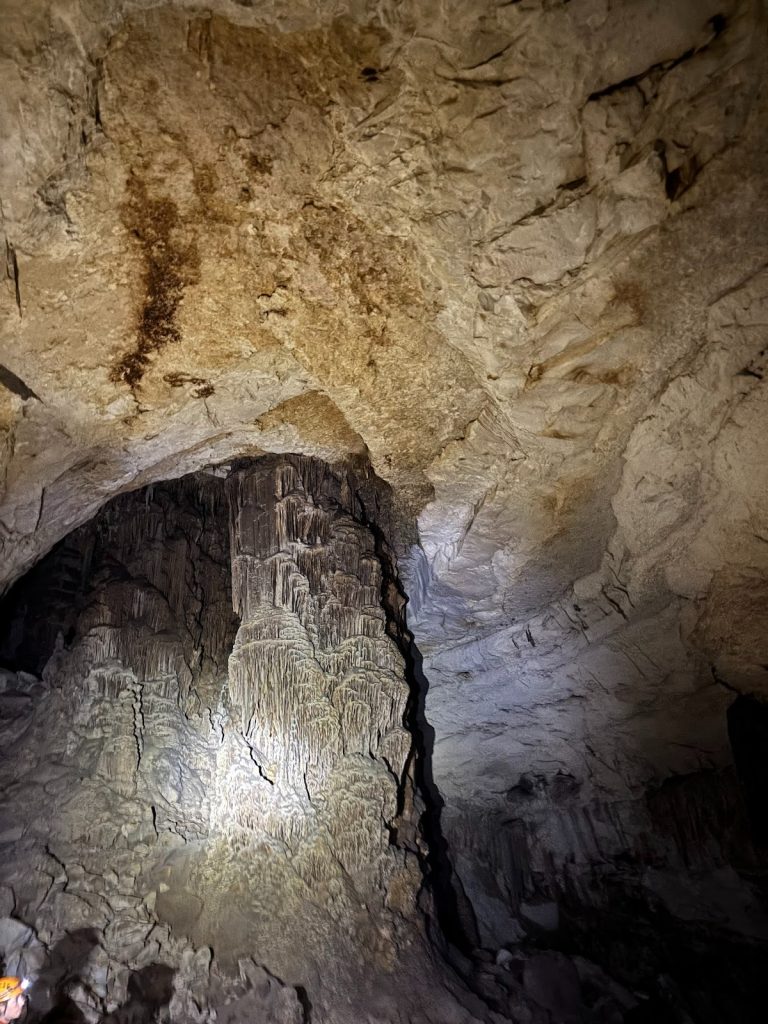Canyons and Camping with a Side of Ranch Outdoor Adventures: Fall Break
Share

Are you ready for a break…again? Reminisce on what some SU students did during Fall Break to briefly exit the overwhelming stress of the rapidly ending semester…
During Fall Break this year, the Outdoor Adventures team organized a three-day trip to the desert to enjoy the break in their classic, particular style. For three days, Outdoor Adventures and nine other students headed to South Texas to rediscover ancient indigenous settlements dating back thousands of years, learn about nature conservation in a protected area, and explore a cave on the verge of collapse. All this and more took place during this memorable long weekend…ready to dive in?
The first day of the trip began early, at 6:00 a.m., so that the team could meet and plan the first stops of the trip. After traveling for nearly five hours, the real adventure began, with students arriving at Lower Pecos Canyonlands to visit The White Shaman, one of the most mysterious pictographic murals in the United States. The White Shaman, dating back 4,000 years, is hidden among the steep canyons of Lower Pecos Canyonlands. A rugged and biologically diverse region of deep canyons in southwestern Texas and northern Mexico, centered mainly on the confluence of the Pecos, Devils, and Rio Grande rivers. Lower Pecos Canyonland is world-renowned for its exceptional archaeological heritage, particularly its well-preserved prehistoric rock art (pictograms) dating back thousands of years, found in numerous dry rock shelters; especially The White Shaman, which has baffled anthropologists and archaeologists alike as they attempt to decipher its meaning.
However, reaching this pictogram is no easy task, nor is it suitable for everyone. To begin with, the path is completely littered with hostile and thorny flora. In addition, you must cross paths of loose, smooth rocks on steep ground. Therefore, a single misstep can cost you a bad fall among the thorns or, if you are lucky, among the prominent rocks that grow out of the ground. Yet, do not be fooled by this description, because the reward at the end of the journey is impressive. The White Shaman, 26 feet long and 13 feet high, is considered an ancient piece of narrative art from North America and is key to understanding the beliefs of the ancient hunter-gatherers who created it. However, although we know when it was painted, we do not know exactly who created this mural or why. In fact, upon arriving at the site where the pictogram is located, the guide said that its meaning is open to imagination, as it is not known what it exactly means. One of the most widely discussed theories is that of archaeologist Dr. Carolyn Boyd in The White Shaman Mural, which interprets the red, black, yellow, and white pigments, suggesting that the images function as a “painted text” that tells the story of the birth of the sun and the beginning of time.
The next stop was Seminole Canyon to set up camp and spend the night in the desert. Seminole Canyon is a prominent canyon in the Lower Pecos Canyonlands of southwestern Texas, known primarily as the center of Seminole Canyon State Park and Historic Site. It is a place of enormous archaeological importance, especially for the extensive and ancient rock art (pictographs) of Native-Americans found in the canyon’s numerous rock shelters. Another thing that makes this place special is its history as an ancient shallow inland sea that covered much of Texas during the Cretaceous period (approximately 100 million years ago). This means that its walls and floor are rich in marine animal fossils, as the canyon is made almost entirely of limestone; thus, finding ammonites scattered on the ground is not unusual. In this part of the state park, you are allowed to explore and hike to the Rio Grande only on the surface, as attempts to preserve the pictographs in the area prohibit going down to the lower part of the canyon without a guide.
To make the most of this place, Outdoor Adventures coordinated with local guides to visit Fate Bell Shelter, the park’s most famous and accessible rock art site, which contains numerous well-preserved murals. Visitors can see large, colorful, and highly stylized images in the Pecos River style, some of which date back approximately 4,000 to 7,000 years. Important archaeological records from the shelter show that it was occupied for more than 8,000 years. The largest of these murals is the one attached to the cover photo of this article. In addition to this one, it is believed that other pictographs are buried underground in this same area, but it has been decided not to unearth them because the soil where this natural gallery is located acted as a giant oven. As a result, any alteration is highly risky because it would not only damage its historical order, but also the pictographs themselves due to the delicacy of their dyes. After a long hike in and out of the canyon, a campout was organized for the night so that the students could better connect with this natural environment and sleep similarly to the ancient settlers.
The second half of the trip took place at Dobb’s Run Ranch. This is a private, family-owned ranch located on the West Nueces River, on the border between Kinney and Edwards counties, at the western end of the Texas Hill Country region. The ranch is best known for its significant wildlife conservation efforts and for being a prime location for bird watching, particularly of endangered species. In addition to birds, Dobb’s Run Ranch is also home to several endangered plants such as the Texas Snowbell, of which there are just over 22 remaining populations, including those within this protected area. The family that owns this ranch welcomed us onto their property on the condition that we learn about the care and treatment that such an important area needs in order to survive intact in the face of the natural changes that threaten it. Therefore, over the next few days, the Outdoor Adventures team and their students committed to working alongside the owners to care for this area, even if only by listening to them, because this is how word spreads about the existence of this ranch so that other conservation organizations will come and support their cause. The team conducted a birding session on the property and also hiked around the ranch to observe its ecosystem.

The last stop before the end of the trip was at Kickapoo Cavern State Park. Kickapoo Cave is the main attraction, a huge, unexploited cave approximately 1,400 feet long that was formed over 4 million years ago by the slow movement of acidic groundwater. It is a “dry” cave, meaning that no new stalactites are currently forming, allowing tour participants to touch some of the formations. The Outdoor Adventures team and their students took advantage of this to climb among the formations and study the history of this place in detail. The cavern has impressive speleothems (cave formations), including an 80-foot-high column, the largest in Texas (the same one shown in the photo above). To explore this enormous underground cave, you need to be in good physical condition because the floor of the cave is made up of its own collapsed ceiling, creating sudden drops that, if not avoided correctly, could result in accidents that are not very serious but extremely embarrassing for those who suffer them. Compared to other caves, this one does not have artificial paths to aid exploration and visits because the aim is to preserve its majesty intact, so it is essential to come adequately prepared.
The park’s caves include Stuart Bat Cave: the park’s second most important cave is the seasonal home to a large colony of up to one million free-tailed Mexican bats. From mid-March to October, visitors can watch the spectacular “bat flight” at sunset, when the bats emerge en masse to hunt insects. Unfortunately, due to the tight schedule prepared for the team’s arrival time and day, the flight of the bats could not be seen. Nevertheless, it is recommended to visit this cave as well, but not without first requesting entry from an authorized guide, as this cave and Kickapoo Cavern are only available with permission from the park’s personnel.
The trip concluded with a gathering around the ranch campfire between the students and the family who had hospitably hosted them. They roasted marshmallows and recounted the most important or memorable events of this trip, along with what they had learned over this extended weekend. I know that, personally, the members of this trip will remember this journey through the Texas desert not only for what their eyes witnessed, but also for what they were able to experience. From the moment they chose the outdoors over the comfort of their homes, they were guaranteed a special Fall Break because that is the classic Outdoor Adventures style. Outdoor Adventures not only creates trips, but also relationships between students and nature that allow them to open up more to their peers and themselves by spending days—or even just a few hours away from home—in order to teach them that there is a world beyond pen and paper.
